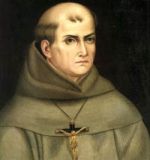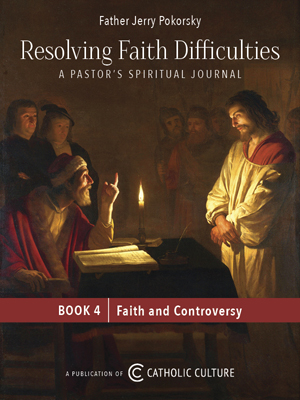Church Fathers: The Lesser Alexandrians
By Thomas V. Mirus ( bio - articles - email ) | Mar 05, 2017 | In Fathers of the Church
Though Clement and Origen were by far the most important members of the School of Alexandria, a number of other associated figures from the third and early fourth centuries are worth mentioning. Their writings are only extant in fragments, if at all.
Ammonius was probably a contemporary of Origen, and may have been the same Ammonius of Alexandria who Eusebius says was Origen’s teacher. Assuming this identity, he is said to have written a Harmony between Moses and Jesus proving the unity of the Old and New Testaments which was denied by the Gnostics, and a synopsis of the four gospels which inspired the Eusebian Canons, a system of tables showing the verse-by-verse similarities and differences between the Gospels. Some early writers confused him with the Neoplatonist Ammonius Saccas.
Dionysius the Great
Dionysius was born to wealthy pagan parents at the end of the second century. It appears that he became Christian as a result of reading widely to find the truth, as he wrote to the priest Philemon:
I indeed gave attention to reading the books and carefully studying the traditions of heretics, to the extent indeed of corrupting my soul with their execrable opinions; yet receiving from them this advantage, that I could refute them in my own mind, and detested them more heartily than ever. And when a certain brother of the order of presbyters sought to deter me, and feared lest I should be involved in the same wicked filthiness, because he said that my mind would be contaminated, and indeed with truth, as I myself perceived, I was strengthened by a vision that was sent me from God. And a word spoken to me, expressly commanded me, saying, ‘Read everything which shall come into thy hands, for thou art fit to do so, who correctest and provest each one; and from them to thee first of all has appeared the cause and the occasion of believing.’
After converting he became Origen’s greatest pupil at the School of Alexandria. In 231 he succeeded Heraclas as head of that school, later succeeding the same man as bishop of Alexandria in 248. His episcopate was plagued with persecutions and he was twice forced to leave his see: during the Decian persecution in 251, and once when he was banished to Kephro in 257 during the Valerian perseucution. He returned to Alexandria in 262 to be greeted by civil war, pestilence and famine. He died during the Synod of Antioch in 264-265, which he had been unable to attend due to his illness.
Dionysius was an influential public figure and weighed in on matters both doctrinal and disciplinary. He was also a great peacemaker, advocating mercy towards those who had lapsed in faith during the persecutions. Though he disagreed with the opinion of (eventual saint) Cyprian of Carthage that baptism administered by heretics is invalid, he begged Pope St. Stephen not to excommunicate the Churches of Asia because of Cyprian’s refusal to accept the Pope’s judgment on the matter.
Eusebius called him “the Great” and St. Athanasius, who wrote a work on The Opinion of Dionysius, called him a Doctor of the Church. Only two complete letters by Dionysius survive, but thanks to these two later Fathers we have fragments of his other writings.
Dionysius wrote a work On Nature, a letter addressed to his son Timothy, which refuted the materialist Epicurean theory that the universe was created from a mere random collision of atoms. His two books On Promises refuted the millennialism of the late bishop Nepos of Arsinoe, which, through no ill intention of the bishop, had apparently caused schisms after the bishop’s death. Notably, Dionysius, while holding the book of Revelations in high esteem, argued that it was written by some other John than the Evangelist based on stylistic differences. He also visited Arsinoe and held a peaceful public discussion in which Coracion, the leader of the millenialists, was finally convinced of the error of his position.
There were some who accused Dionysius of Trinitarian subordinationism and denounced him to Pope St. Dionysius. The Pope wrote to the Alexandrian asking him to explain his views on the Trinity, and in response the latter composed a Refutation and Apology in four books, which satisfied the Pope.
He wrote a letter to the schismatic and antipope Novatian, urging him to stand down and reunite his followers to the Church. In contrast to Novatian’s rigorist views, Dionysius’s letter to Fabius, bishop of Antioch, states that absolution and the Eucharist should be refused to nobody who requests it on their deathbed, even those who had apostatized during persecutions. Another letter was to the bishop Basilides of the Pentapolis, on the topic of the duration of Lent and the physical conditions for reception of the Eucharist. We also have fragments of so-called festal letters by Dionysius. Of these Quasten writes:
“Up to the ninth century, it was a custom among the bishops of Alexandria to send every year to all the Churches of Egypt an announcement of the date of Easter and the beginning of the preceding fast. This took the form of a pastoral epistle exhorting the congregation to observe the Lenten and the Easter season carefully. Dionysius of Alexandria is the first bishop known to have sent such a letter.” [Patrology Vol. II, p. 108]
There survive fragments of commentaries on Ecclesiastes, Luke and John which may have been written by Dionysius. According to Eusebius, he also wrote a work On Temptations, of which we only know the title.
Theognostus was apparently a successor of Dionysius as head of the school of Alexandria, though the order of succession is unclear. Only very brief fragments of his seven-volume work, the Hypotyposeis, survive; we know of him mainly from the writings of St. Athanasius and of the ninth-century Patriarch of Constantinople, Photius. Apparently he was not quite orthodox, following at times some of Origen’s more problematic ideas about the relation of the Son and the Holy Spirit to the Father. Nonetheless, Athanasius admired him and cited him in his battle with the Arians; and like Origen, Theognostus apparently influenced the theology of St. Gregory of Nyssa.
Pierius was another school head who either succeeded or preceded Theognostus. He was known for living a life of voluntary poverty and, St. Jerome relates, was so brilliant and prolific that he was nicknamed Origen Junior. He suffered during the persecution of Diocletian in Alexandria, after which he spent the rest of his life in Rome (which lasted at least until 309). Photius mentions having read a collection of twelve sermons by Pierius, including a long one on the prophet Hosea; he notes with approval that Pierius was orthodox on the relation between Father and Son, while complaining that he held the Holy Spirit to be inferior to these. An historian about a century later, Philip of Side, mentions three works by Pierius: On the Gospel of Luke, On the Mother of God (if only this survived!), and a Life of his great student, the martyr St. Pamphilus of Caesarea.
St. Peter of Alexandria
Peter succeeded Theonas as bishop of Alexandria around 300 and was martyred around 311. He may earlier have been a head of the catechetical school, though he was an anti-Origenist.
Three years into his rule, he was forced to leave for a time by Diocletian’s persecution. At this time the bishop of Lycopolis, Meletius, began to invade and take over the dioceses of bishops whose rule had been disrupted by persecution: he usurped the rule of Alexandria and four other sees. Returning to Alexandria, Peter held a synod deposing Meletius and convicting him of crimes including sacrificing to the gods. Meletius then began a schism, the rigorist “church of the martyrs”, which lasted for centuries. In fact, the arch-heretic Arius was himself a Meletian, and found ready followers among this sect.
In a lost work On Penance, St. Peter wrote canons on the treatment of lapsi who had denied their faith under persecution, which were preserved as part of Eastern canon law. Of his other writings only small fragments remain. These other works include On the Godhead, written against subordinationism and quoted in the 431 Council of Ephesus; On the Advent of our Savior; On the Soul, written against Origen’s doctrine of the preexistence of the soul; On the Resurrection, possibly arguing (against Origen) that the resurrected body will be the same body as this present one; On Easter; and a letter to the Alexandrians warning them against Meletius.
In the fourth century, the Churches of Egypt and Alexandria used a redaction of the Septuagint (and possibly of the Gospels as well) by Hesychius. St. Jerome strongly disliked it, accusing Hesychius of having made his own additions to Scripture. He shares his name with one of the martyred bishops whose see was usurped by Meletius, but it is unknown if they were the same person.
The Apostolic Church Order, or Ecclesiastical Canons of the Holy Apostles, is an important source of ecclesiastical law. It claims to have been written by the twelve apostles but was probably written in early fourth-century Egypt. The high regard in which it was held is indicated by translations from the original Greek into Latin, Syriac, Coptic, Arabic and Ethiopic. The first half consists of moral precepts adapted from the Didache and arranged in the same “two ways” form. The second half contains regulations for the election of bishops, priests, lectors, deacons and widows.
Previous in series: Origen’s Theology
All comments are moderated. To lighten our editing burden, only current donors are allowed to Sound Off. If you are a current donor, log in to see the comment form; otherwise please support our work, and Sound Off!








